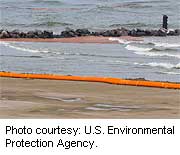
WEDNESDAY, June 29 (HealthDay News) — As the summer gets into full swing, a new report Wednesday warns that water pollution can make a day at the beach no day at the beach.
Last year was one of the worst in two decades for pollution-related beach closures and warnings, partly due to the Gulf of Mexico oil spill and rainy weather, according to the report from the Natural Resources Defense Council (NRDC), an environmental activist group.
Going to the beach is “a summer rite of passage, but, unfortunately, it can also make you sick,” David Beckman, director of the council’s Water Program told a morning press conference Wednesday.
“America’s beaches have long suffered from pollution, including bacteria-laden human and animal waste,” he added. “The biggest known source of this contamination is polluted stormwater runoff.”
This contamination can make people sick with the stomach flu, rashes, pinkeye, dysentery, hepatitis, ear, nose and throat problems, and other diseases, Beckman said.
The report, the 21st annual Testing the Waters: A Guide to Water Quality at Vacation Beaches, analyzed government data on beachwater test results from more than 3,000 beaches nationwide. As in past years, the report found that much of the beachwater is contaminated from oil, and human and animal waste.
Beaches — including inland ones not near an ocean — were closed or warnings were issued for 24,091 days in 2010, an increase of 29 percent from 2009, making it the second worst year in the last 21 years. Much of the contamination was the result of sewage spills and stormwater runoff, exacerbated by heavy rainfall in Hawaii and unknown sources of pollution in California, according to the report.
The massive Gulf of Mexico oil spill played a major role, too, often closing beaches in the Gulf region. The report also noted that the BP spill continues to take a toll on water quality in the Gulf. By the end of January, 83 miles of coastline were still contaminated with oil and tar balls, and oil continues to wash ashore.
Overall, the report showed that monitoring samples had signs of contamination about 8 percent of the time, meaning that beaches were unsafe, said Jon Devine, senior attorney at the NRDC.
The geographic area with the most frequently contaminated beaches in 2010 was the Great Lakes — 15 percent of water samples violated public health standards.
The southeast United States, the New York-New Jersey coast and Delaware/Maryland/Virginia region were the cleanest at 4 percent, 5 percent and 6 percent, respectively, according to the report.
States with the highest rates of contamination were Louisiana (37 percent), Ohio (21 percent) and Indiana (16 percent). Those with the lowest rates last year were New Hampshire (1 percent), New Jersey (2 percent), Oregon (3 percent), Hawaii (3 percent) and Delaware (3 percent).
The report also cited the “Top 10 Repeat Offenders” — beaches that were deemed unhealthy more than one-quarter of the time from 2006 to 2010. California led the list:
- California: Avalon Beach in Los Angeles County (three of five monitored sections) — Avalon Beach Near Busy B Cafe, Avalon Beach North of GP Pier, Avalon Beach South of GP Pier.
- California: Cabrillo Beach in Los Angeles County.
- California: Doheny State Beach in Orange County (two of six monitored sections) — Doheny State Beach North of San Juan Creek, Doheny State Beach Surfzone at Outfall.
- Florida: Keaton Beach in Taylor County.
- Illinois: North Point Marina North Beach in Lake County.
- New Jersey: Beachwood Beach West in Ocean County.
- Ohio: Villa Angela State Park in Cuyahoga County.
- Texas: Ropes Park in Nueces County.
- Wisconsin: Eichelman Beach in Kenosha County.
- Wisconsin: South Shore Beach in Milwaukee.
The report lauded four beaches that got the highest ratings for water quality and followed the “best practices” for water monitoring and notification of the public when problems occurred:
- Delaware: Rehoboth Beach-Rehoboth Avenue Beach in Sussex County.
- Delaware: Dewey Beach in Sussex County.
- Minnesota: Park Point Lafayette Community Club Beach, in St. Louis County.
- New Hampshire: Hampton Beach State Park in Rockingham County.
Devine said it was possible to do more to improve water quality at the beach, but it requires a big effort across communities, not just where the water begins.
“Cities and communities around the country are proving that investing in smarter, greener infrastructure and practices on the land — things like porous pavement, green roofs and roadside plantings — will make a real difference,” Devine told HealthDay. Some of these approaches are designed to limit runoff from rainfall by allowing water to seep back into the land or be stored.
Monitoring practices can be improved too, Devine added, through more frequent testing of water quality and outreach to the public about the results. In some cases, beaches are polluted for some time before monitoring systems detect a problem.
Adina Paytan, a research professor and marine scientist at the University of California, Santa Cruz, said the new report seems accurate and its conclusions are valid. There are challenges to be met, she said, including the cost of preventing beach pollution.
Paytan added that it would be helpful to understand how the expenses of pollution prevention compare to the possible financial benefits of cleaner beaches, such as economic savings in affected communities.
More information
For more about beach pollution, visit the U.S. Environmental Protection Agency.

